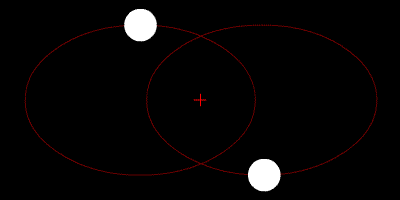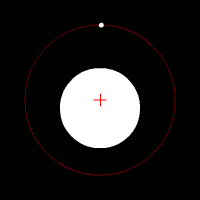
Image 1 Caption: An animation of a (gravitationally-bound) gavitational two-body system with two spherically symmetric, equal-mass astro-bodies orbiting in elliptical orbits around their common center of mass which marked by a red cross.
The gavitational two-body system is, of course, a special case of a center-of-mass (CM) inertial frame,
The astro-bodies sizes are vastly exaggerated relative to the separation distances for most binary systems---but NOT all---there are some very close binary systems.
Features of general gravitational two-body systems:
- The center of mass
is a focus for
both elliptical orbits.
The other focuses
are just empty points in physical space
with NO significant meaning.
- The elliptical orbits
of all
gravitational two-body systems
are determined by
Newtonian physics
(what is universal about the
physical system)
and initial conditions
(what is peculiar or individual about the physical system).
- Gravity is, of course, the
force that pulls
the astro-bodies into
orbits.
- The
periapsis
(AKA pericenter)
is the arrangement of closest separation and the term is
also used for the closest separation distance.
- The
apoapsis
(AKA apocenter)
is the arrangement of farthest separation and the term is
also used for the farthest separation distance.
- The apse line (AKA line of apsides)
is drawn through the periapsis
and apoapsis.
- The RELATIVE
mean orbital radius
(AKA RELATIVE
semi-major axis) is given by
a=(1/2)*( r_periapsis +r_apoapsis ) ,where r_periapsis is the periapsis separation and r_apoapsis is the apoapsis separation.For the formulae for orbital radii relative to the center of mass (which are absolute in center-of-mass (CM) inertial frame), see Orbit file: orbit_apsis.html.
- In most real
orbits,
astronomical perturbations
cause noticeable deviations from exact
two-body system
behavior.

Image 2 Caption: A gravitationally-bound gavitational two-body system with a large difference in mass between the two spherically-symmetric astro-bodies orbiting in circular orbits their common center of mass which marked by a red cross.
- If the mass
of smaller body were negligible compared to that of the larger body,
the more massive body would NOT be seen by the eye to be moving.
In this case, the more massive body center would effectively be the center of mass of the gavitational two-body system.
- For circular orbits,
there is only one
focus which in
math jargon
is to say the two focuses
are mathematically degenerate.
- The
periapsis
and apoapsis
are also
mathematically degenerate:
i.e., they have been squeezed to the same value and the relative
orbital radius
is a contant.
- This
two-body system
could be, e.g., a
close binary star system
a close star and
planet system,
or a close planet and
moon system.
-
Images:
- Credit/Permission: User:Zhatt,
before or circa 2005
(uploaded to Wikipedia by
User:Julo,
2005) /
Public domain.
Image link: Wikipedia: File:Orbit5.gif.
- Credit/Permission: User:Zhatt,
before or circa 2005
(uploaded to Wikipedia by
User:Julo,
2005) /
Public domain.
Image link: Wikipedia: File:Orbit4.gif.
File: Orbit file: orbit_elliptical_explication.html.